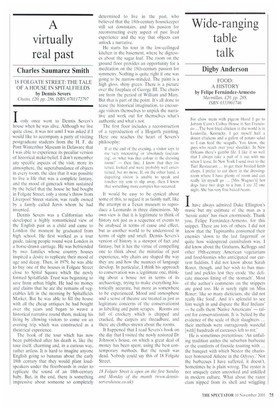A virtually real past
Charles Saumarez Smith
18 FOLGATE STREET: THE TALE OF A HOUSE IN SPITALFIELDS by Dennis Severs Chatto,120, pp. 286, ISBN 0701172797 Ionly once went to Dennis Severs's house when he was alive. Although we live quite close, it was not until I was asked if I would like to accompany a party of visiting postgraduate students from the H. F. du Pont Winterthur Museum in Delaware that I was able to experience its peculiar version of historical make-belief. I don't remember any specific aspects of the visit, more its atmosphere, the superabundance of objects in every room, the idea that it was possible to live a life that was a complete fantasy, and the mood of gimcrack whim sustained by the belief that the house he had bought in Folgate Street, only a stone's throw from Liverpool Street station, was really owned by a family called Jervis whom he had invented.
Dennis Severs was a Californian who developed a highly romanticised view of the English past as a child and came to London the moment he graduated from high school. He first worked as a tour guide, taking people round west London in a horse-drawn carriage. He was befriended by two families whose country houses inspired a desire to replicate their mood of age and decay. Then, in 1979, he was able to buy one of the houses in Folgate Street close to Spital Square which the newly formed Spitalfields Trust was beginning to save from urban blight. He had no money and claims that he ate the remains of vegetables left in the morning by Spitalfields Market. But he was able to fill the house with all the cheap antiques he had bought over the years and began to weave a historical narrative round them, making his living by allowing visitors to come on an evening trip which was constructed as a theatrical experience.
The book of the tour which has now been published after his death is, like the tour itself, charming and, in a curious way, rather artless. It is hard to imagine anyone English going so bananas about the early 18th century that they would plant loudspeakers under the floorboards in order to replicate the sound of an 18th-century baby. But, in the end, there is something impressive about someone so completely determined to live in the past, who believed that the 18th-century housekeeper still sat downstairs, and his passion for reconstructing every aspect of past lived experience and the way that objects can unlock a narrative.
He starts his tour in the low-ceilinged kitchen in the basement, where he digresses about the sugar loaf. The room on the ground floor provides an opportunity for a meditation on the 18th-century passion for symmetry. Nothing is quite right if one was going to be narrow-minded. The paint is a high gloss, shiny green. There is a picture over the fireplace of George III. The chairs are from the period of William and Mary. But that is part of the point. It's all done to tease the historical imagination, to encourage visitors themselves to unpick the narrative and work out for themselves what's authentic and what's not.
The first floor includes a reconstruction of a reproduction of a Hogarth painting. Here one reaches the heart of Severs's philosophy:
If at the end of the evening, a visitor says to me 'very interesting' or 'absolutely fascinating'. or 'what was that colour in the dressing room? — then fine, I know that they listened. looked and were probably well entertained. but no more. If, on the other hand, a departing visitor is unable to speak and touches my arm to slip away, then I know that something more complex has occurred.
It would be easy to be cynical about some of this, to regard it as faintly miff, like the attempt in a Texan museum to reproduce a Leonardo in three dimensions. My own view is that it is legitimate to think of history not just as a sequence of events to be analysed in terms of cause and effect, but as another world to be understood in terms of sight and smell. Dennis Severs's version of history is a stewpot of fact and fantasy, but it has the virtue of compelling one to think about the minutiae of past experience, why chairs are shaped the way they are and how the nuances of language develop. In particular, I think his approach to conservation was a legitimate one, thinking about a house not in terms of its archaeology, trying to make everything historically accurate, but more as somewhere to be experienced. Mood and atmosphere and a sense of theatre are treated as just as legitimate concerns of the conservationist as labelling and paint scrapes. Rooms are full of crockery which is chipped and cracked, the carpets are threadbare, and there are clothes strewn about the rooms.
It happened that I read Severs's book on the day that I visited the newly restored Dr Johnson's house, on which a great deal of money has been spent, using the best contemporary methods. But the result was dead. Nobody could say this of 18 Folgate Street.
18 Folgate Street is open on the first Sunday and Monday of the month (www.dennisservershouse.co.uk)














































































































 Previous page
Previous page